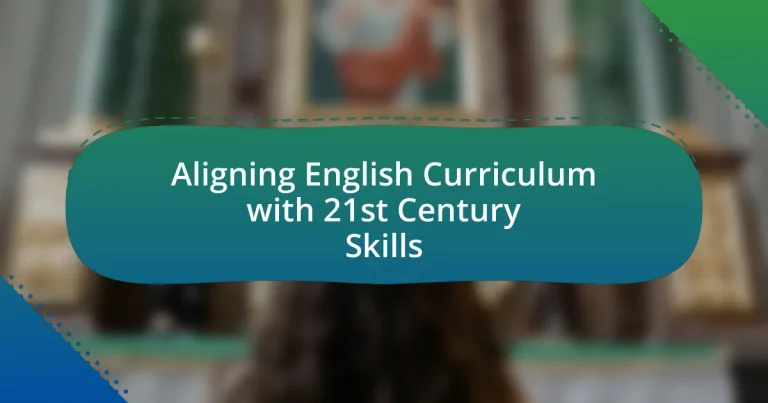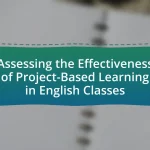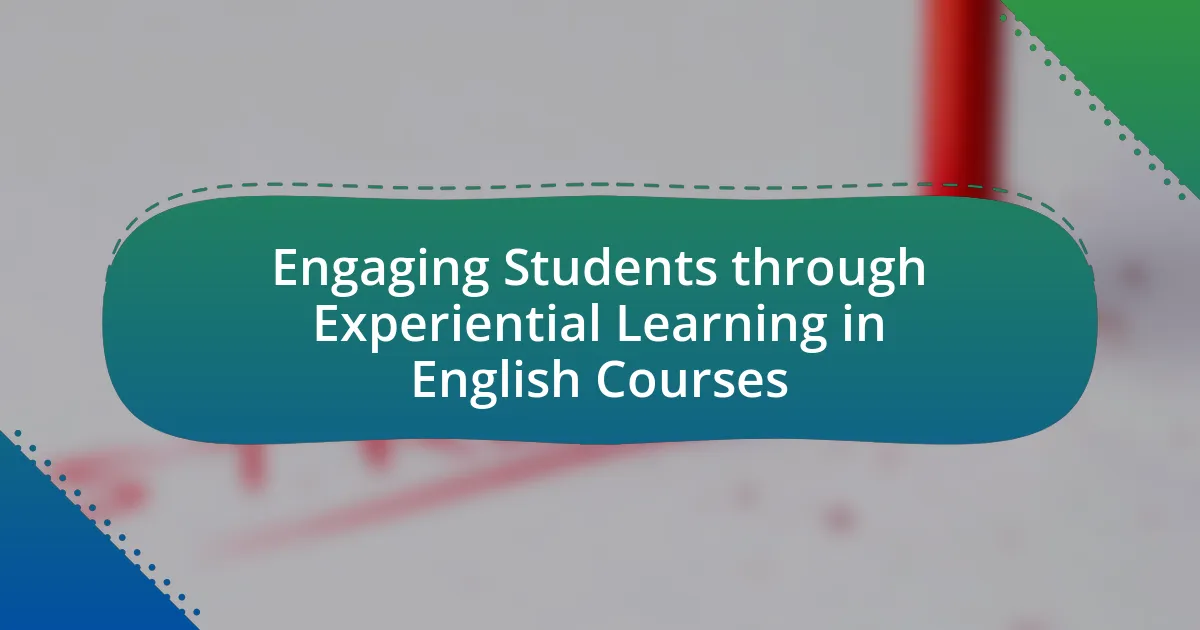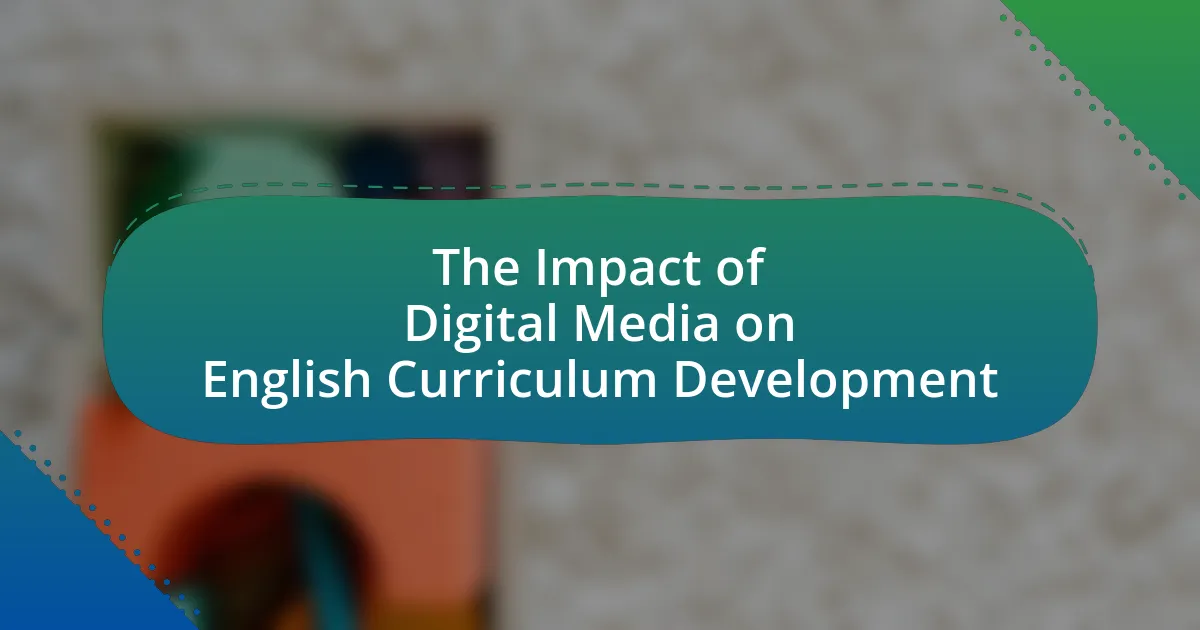The article focuses on aligning the English curriculum with 21st-century skills, emphasizing the integration of critical thinking, collaboration, communication, and creativity into language learning. It discusses how this alignment enhances student engagement and academic outcomes, preparing learners for modern workforce demands. Key strategies for implementation include project-based learning, technology integration, and fostering collaborative environments. The article also addresses challenges educators may face, such as resistance to change and resource limitations, while highlighting the importance of continuous professional development and effective assessments in maintaining alignment with essential skills.
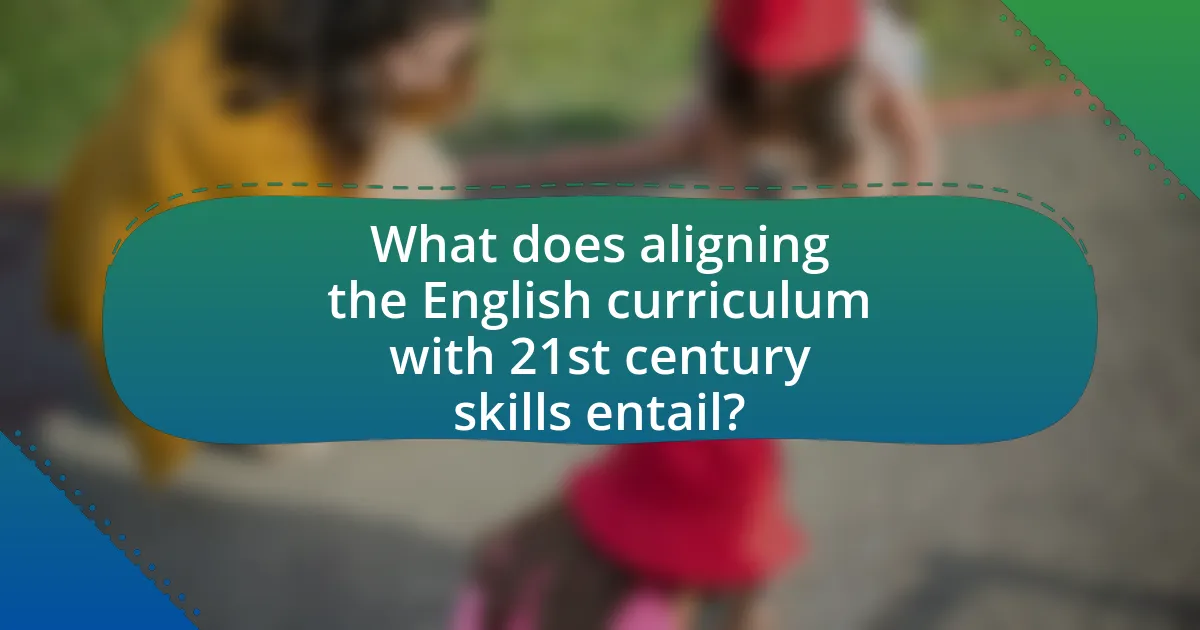
What does aligning the English curriculum with 21st century skills entail?
Aligning the English curriculum with 21st century skills entails integrating critical thinking, collaboration, communication, and creativity into language learning. This approach emphasizes the development of competencies that prepare students for modern challenges, such as digital literacy and global awareness. Research indicates that curricula incorporating these skills enhance student engagement and improve academic outcomes, as evidenced by studies showing that students who engage in collaborative projects demonstrate higher levels of critical thinking and problem-solving abilities.
How do 21st century skills influence the English curriculum?
21st century skills significantly influence the English curriculum by integrating critical thinking, collaboration, communication, and creativity into learning objectives. These skills shift the focus from traditional rote learning to a more interactive and engaging approach, fostering students’ ability to analyze texts, participate in discussions, and express ideas effectively. For instance, the incorporation of project-based learning in English classes encourages students to work together on assignments, enhancing their teamwork and problem-solving abilities. Research by the Partnership for 21st Century Skills highlights that curricula emphasizing these skills lead to improved student engagement and better preparation for real-world challenges.
What are the key 21st century skills relevant to English education?
The key 21st century skills relevant to English education include critical thinking, communication, collaboration, creativity, digital literacy, and information literacy. Critical thinking enables students to analyze texts and arguments effectively, while communication skills enhance their ability to express ideas clearly in both written and spoken forms. Collaboration fosters teamwork in projects and discussions, and creativity encourages innovative thinking in writing and problem-solving. Digital literacy is essential for navigating online resources and tools, and information literacy helps students evaluate sources and synthesize information. These skills are supported by educational frameworks such as the Partnership for 21st Century Skills, which emphasizes their importance in preparing students for a complex, interconnected world.
How can these skills be integrated into English language teaching?
Skills can be integrated into English language teaching by incorporating collaborative projects, critical thinking exercises, and digital literacy activities into the curriculum. Collaborative projects encourage students to work together, enhancing communication skills and teamwork, which are essential 21st-century skills. Critical thinking exercises, such as analyzing texts or debating topics, foster analytical skills and the ability to evaluate information critically. Digital literacy activities, including using online resources and tools for research and presentations, prepare students for a technology-driven world. Research by the Partnership for 21st Century Skills emphasizes the importance of integrating these competencies into education to better prepare students for future challenges.
Why is it important to align the English curriculum with modern skills?
Aligning the English curriculum with modern skills is crucial for preparing students for the demands of the contemporary workforce. This alignment ensures that students develop critical thinking, communication, and digital literacy skills, which are essential in today’s job market. Research from the World Economic Forum indicates that 21st-century skills, including creativity and collaboration, are increasingly valued by employers. By integrating these skills into the English curriculum, educators can enhance students’ ability to navigate complex information and engage effectively in diverse environments.
What are the benefits of this alignment for students?
The alignment of the English curriculum with 21st-century skills benefits students by enhancing their critical thinking, communication, and collaboration abilities. This alignment fosters a learning environment that emphasizes real-world applications of language skills, preparing students for modern workplace demands. Research indicates that students engaged in curricula that integrate these skills demonstrate improved problem-solving capabilities and adaptability, essential traits in today’s job market. For instance, a study by the Partnership for 21st Century Skills highlights that students who develop these competencies are more likely to succeed academically and professionally, as they can effectively navigate complex information and work collaboratively in diverse teams.
How does this alignment prepare students for future challenges?
Aligning the English curriculum with 21st-century skills prepares students for future challenges by equipping them with critical thinking, communication, collaboration, and creativity skills essential for the modern workforce. This alignment fosters an environment where students engage in problem-solving and real-world applications of their knowledge, enhancing their adaptability to various situations. Research indicates that educational frameworks emphasizing these skills lead to improved student outcomes, as seen in the Partnership for 21st Century Skills initiative, which highlights the importance of integrating core subjects with 21st-century themes. By focusing on these competencies, students become better prepared to navigate the complexities of a rapidly changing global landscape.
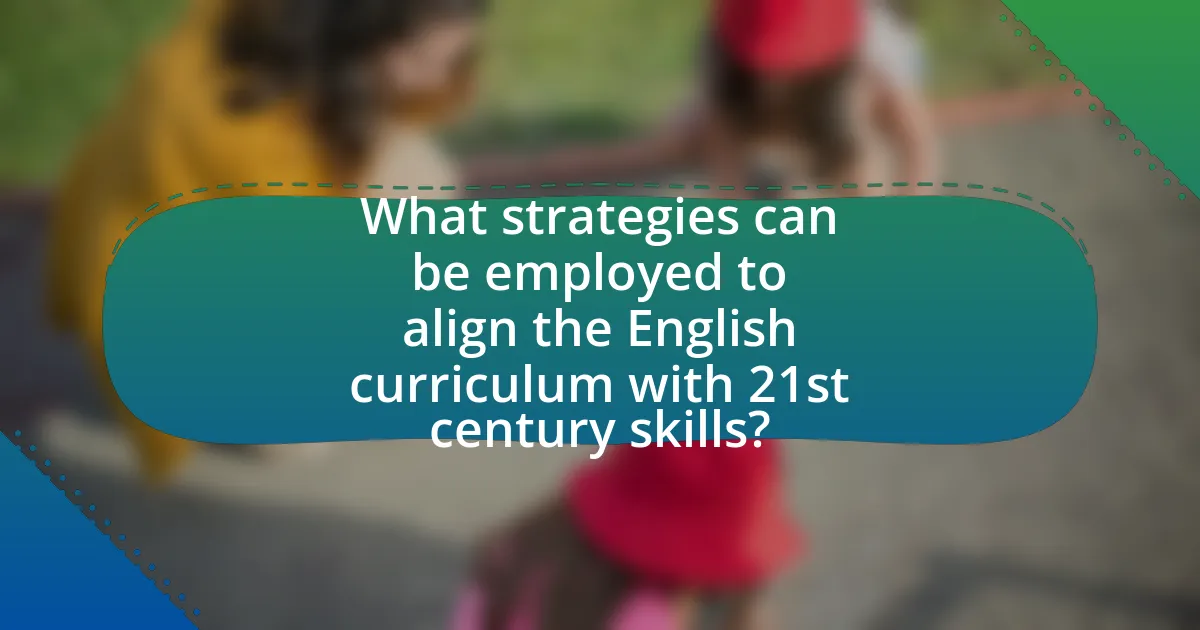
What strategies can be employed to align the English curriculum with 21st century skills?
To align the English curriculum with 21st century skills, educators can implement project-based learning, integrate technology, and emphasize critical thinking and collaboration. Project-based learning allows students to engage in real-world problems, fostering skills such as problem-solving and teamwork. Integrating technology, such as digital storytelling and online collaboration tools, enhances students’ digital literacy, which is essential in today’s workforce. Furthermore, emphasizing critical thinking through discussions, debates, and analytical writing prepares students to evaluate information and make informed decisions. These strategies are supported by educational research indicating that active learning environments significantly improve student engagement and skill acquisition.
How can educators effectively implement these strategies?
Educators can effectively implement strategies for aligning the English curriculum with 21st-century skills by integrating project-based learning, technology, and collaborative activities into their lesson plans. Research indicates that project-based learning enhances critical thinking and problem-solving skills, which are essential for students in the modern workforce. For instance, a study by the Buck Institute for Education found that students engaged in project-based learning demonstrated higher levels of engagement and retention of knowledge compared to traditional teaching methods. Additionally, incorporating technology, such as digital storytelling and online collaboration tools, allows students to develop digital literacy and communication skills, which are vital in today’s job market. By fostering a collaborative classroom environment, educators can encourage teamwork and interpersonal skills, further preparing students for real-world challenges.
What role does technology play in this implementation?
Technology plays a crucial role in aligning the English curriculum with 21st-century skills by facilitating interactive learning experiences and providing access to diverse resources. It enables educators to incorporate digital tools, such as online collaboration platforms and multimedia content, which enhance student engagement and foster critical thinking. For instance, research by the International Society for Technology in Education highlights that technology integration in education improves student outcomes by promoting personalized learning and collaboration. This evidence supports the assertion that technology is essential for modernizing the English curriculum to meet the demands of today’s learners.
How can collaborative learning enhance the curriculum alignment?
Collaborative learning enhances curriculum alignment by fostering active engagement among students, which aligns educational practices with 21st-century skills such as critical thinking, communication, and teamwork. This approach encourages students to work together, share diverse perspectives, and solve problems collectively, thereby reinforcing the curriculum’s relevance to real-world applications. Research indicates that collaborative learning environments lead to improved academic outcomes and deeper understanding of content, as evidenced by a study published in the “Journal of Educational Psychology,” which found that students in collaborative settings demonstrated higher levels of achievement and retention compared to those in traditional learning environments.
What challenges might educators face in this alignment process?
Educators may face several challenges in the alignment process of the English curriculum with 21st-century skills, including resistance to change, lack of resources, and insufficient professional development. Resistance to change often stems from established teaching practices and a reluctance to adopt new methodologies that emphasize critical thinking and collaboration. Additionally, many educators encounter a lack of resources, such as updated materials and technology, which are essential for implementing innovative teaching strategies. Furthermore, insufficient professional development opportunities can hinder educators’ ability to effectively integrate 21st-century skills into their curriculum, as they may not receive adequate training on new pedagogical approaches or assessment methods. These challenges collectively impede the successful alignment of the curriculum with the skills necessary for students to thrive in a modern, dynamic environment.
How can resistance to change be addressed?
Resistance to change can be addressed by implementing effective communication strategies and involving stakeholders in the change process. Engaging educators, students, and parents in discussions about the benefits of aligning the English curriculum with 21st-century skills fosters a sense of ownership and reduces apprehension. Research indicates that organizations that prioritize transparent communication and stakeholder involvement experience a 70% higher success rate in change initiatives (Kotter, 1996). By providing training and resources that demonstrate the relevance of new skills, resistance can be further mitigated, as individuals are more likely to embrace change when they understand its purpose and benefits.
What resources are available to support educators in overcoming these challenges?
Educators can access various resources to support them in overcoming challenges related to aligning English curriculum with 21st-century skills. Professional development programs, such as workshops and online courses, provide educators with strategies and tools to integrate critical thinking, collaboration, and digital literacy into their teaching. Organizations like the International Society for Technology in Education (ISTE) offer frameworks and resources that guide educators in implementing technology effectively in the classroom. Additionally, curriculum guides and lesson plans from educational publishers, such as Pearson and McGraw-Hill, are designed to align with contemporary educational standards and skills. Research from the Partnership for 21st Century Skills emphasizes the importance of integrating these skills into the curriculum, providing a solid foundation for educators seeking to enhance their teaching practices.
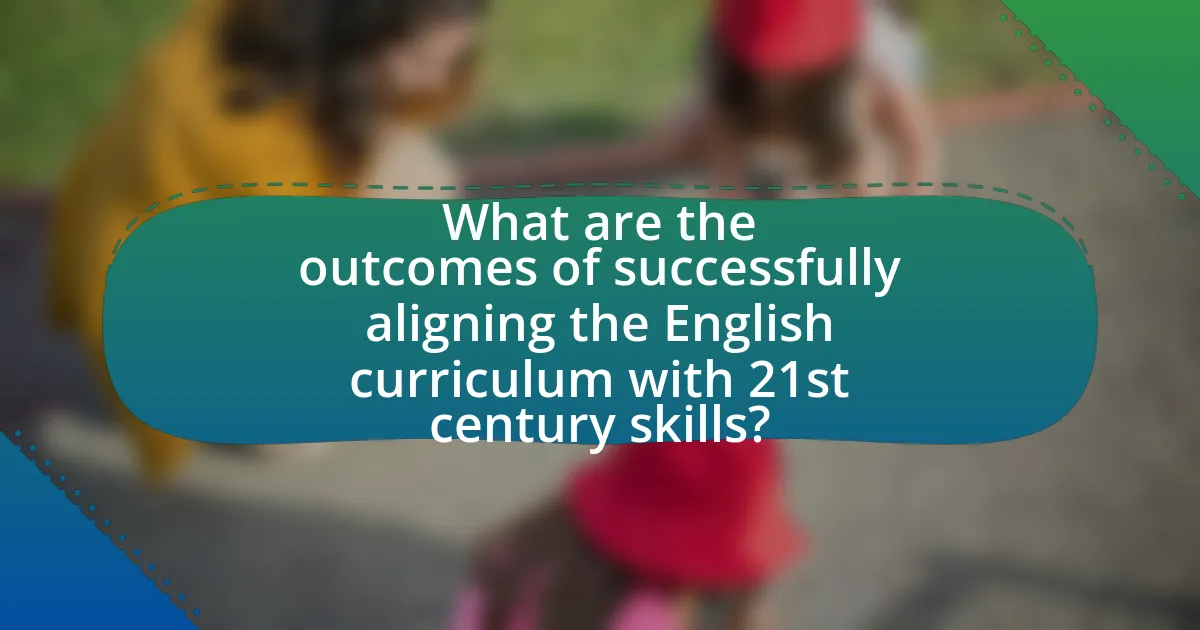
What are the outcomes of successfully aligning the English curriculum with 21st century skills?
Successfully aligning the English curriculum with 21st century skills enhances students’ critical thinking, communication, collaboration, and creativity. This alignment prepares students for real-world challenges by integrating technology and fostering adaptability. Research indicates that students exposed to curricula emphasizing these skills demonstrate improved problem-solving abilities and higher engagement levels, as evidenced by a study from the Partnership for 21st Century Skills, which found that such educational approaches lead to better academic performance and readiness for the workforce.
How does this alignment impact student engagement and learning outcomes?
Aligning the English curriculum with 21st-century skills significantly enhances student engagement and learning outcomes. This alignment fosters critical thinking, collaboration, and communication skills, which are essential in today’s workforce. Research indicates that when curricula incorporate real-world applications and interdisciplinary approaches, students demonstrate higher motivation and improved academic performance. For instance, a study by the Partnership for 21st Century Skills found that students engaged in project-based learning, which aligns with these skills, showed a 30% increase in engagement levels and a 20% improvement in standardized test scores. Thus, the integration of 21st-century skills into the English curriculum directly correlates with enhanced student engagement and better learning outcomes.
What evidence supports the effectiveness of this alignment?
Evidence supporting the effectiveness of aligning the English curriculum with 21st-century skills includes improved student engagement and enhanced critical thinking abilities. Research conducted by the Partnership for 21st Century Skills demonstrates that curricula integrating critical thinking, collaboration, and communication skills lead to higher student performance on standardized assessments. Additionally, a study published in the Journal of Educational Psychology found that students exposed to a curriculum emphasizing these skills showed a 15% increase in problem-solving abilities compared to those in traditional settings. These findings indicate that such alignment not only fosters essential skills but also positively impacts academic outcomes.
How can success be measured in this context?
Success in aligning the English curriculum with 21st-century skills can be measured through student engagement, critical thinking development, and proficiency in communication. These metrics indicate how well the curriculum prepares students for real-world challenges. For instance, increased student participation in discussions and projects reflects higher engagement levels, while assessments that evaluate critical thinking skills demonstrate the curriculum’s effectiveness in fostering analytical abilities. Additionally, standardized tests that measure communication skills, such as writing and speaking assessments, provide concrete evidence of student proficiency in essential competencies required in modern workplaces.
What best practices should educators follow for effective curriculum alignment?
Educators should follow a systematic approach to ensure effective curriculum alignment, which includes defining clear learning objectives, integrating assessments, and ensuring coherence across grade levels. Clear learning objectives provide a roadmap for what students need to achieve, while integrated assessments help measure student progress towards these objectives. Additionally, coherence across grade levels ensures that skills build progressively, facilitating a smoother transition for students. Research indicates that schools implementing these practices see improved student outcomes, as evidenced by a study from the Center for Education Policy Research at Harvard University, which found that aligned curricula significantly enhance student performance in standardized assessments.
How can continuous professional development support this alignment?
Continuous professional development (CPD) supports the alignment of the English curriculum with 21st-century skills by equipping educators with the latest pedagogical strategies and content knowledge. CPD programs focus on enhancing teachers’ understanding of critical skills such as collaboration, communication, and digital literacy, which are essential for preparing students for modern challenges. Research indicates that teachers who engage in ongoing professional development are more likely to implement innovative teaching practices that foster these skills in their students, thereby ensuring that the curriculum remains relevant and effective in a rapidly changing world.
What role do assessments play in maintaining alignment with 21st century skills?
Assessments play a critical role in maintaining alignment with 21st century skills by measuring students’ competencies in areas such as critical thinking, collaboration, and digital literacy. These assessments provide educators with data to evaluate whether the curriculum effectively fosters these essential skills. For instance, formative assessments, such as project-based evaluations, allow teachers to gauge students’ application of skills in real-world contexts, ensuring that learning objectives align with the demands of the modern workforce. Furthermore, standardized assessments that incorporate 21st century skills criteria help to benchmark student performance against global standards, reinforcing the importance of these skills in educational outcomes.
